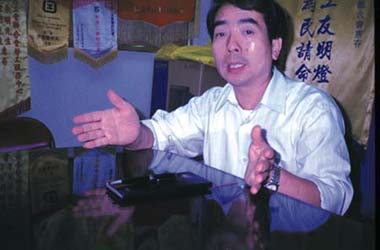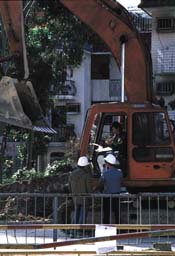|
Less pay or no job Less skilled workers face dilemma By Clara Loon |
Clara Loon |
|
Business and industry leaders claim that there is a labour shortage and demand labour importation while many local workers cannot find suitable jobs. The general secretary of the Hong Kong Confederation of Trade Unions, Mr. Lee Cheuk Yan, said, “Many unemployed workers aged 35 or above have low education levels because the 9-year compulsory free education program was introduced in 1978. “Besides, they have become ‘de-skilled’ because their skills are now dated,” he said. Mr. Leung Fu Wah, vice-chair of the Hong Kong Federation of Trade Unions, said, “Blue-collar labourers aged 35 or above usually received only primary or junior secondary education. “In the past, they worked in factories where specific technical skills were not required.” Added Mr. Lee: “On the other hand, demand for labour has generally become stronger in the service sector than in manufacturing. The occupational composition of the local work force has become increasingly oriented towards services.” Mr. Leung pointed out that, because of the restructuring of the economy, the number of workers engaged in manufacturing declined from 90,000 in the ’80s to 30,000 today. Said he: “Basically, the service sector is composed of professional, clerical and unskilled jobs. Unemployed labourers from the manufacturing sector can only turn to unskilled jobs.” In general, there is a shortage of labour for professional and clerical posts. Their salaries are increasing while blue-collar salaries are falling. “However, there are fewer vacancies for unskilled workers because of increasing mechanisation and automation. This requires workers with greater technical skills, which they basically lack,” said Mr. Leung. As a result, many manufacturing workers have had to change jobs because underemployment or retrenchment or closure of companies. According to Mr. Leung, these workers have no choice but to accept the same job at lower wages or longer working hours. |
|
This also results in a lack of spare time to attend retraining programmes. “Of course, local businessmen want to import Mainland workers, whose original wages are one-fifth or one-sixth of those in Hong Kong,” said Mr. Leung. Until June 30, the Government granted 2,009 foreign worker visas under the Supplementary Labour Scheme operating under the Importation of Labour Schemes of the Labour Department. Construction workers accounted for 24.2 percent of the foreign workers, while another 11 percent work on pig farms. Others work in nursing homes. |
 A service-oriented economy increases chances of unemployment of some kinds of workers. |
|
There are three schemes in operation under the Importation of Labour Scheme: the Supplementary Labour Scheme, the Special Labour Importation Scheme for the New Airport and Related Projects, and the Pilot Scheme for the entry of 1,000 PRC (People’s Republic of China) professionals. Said Mr. Leung: “Based on the questionnaires distributed to our members, we found that they are satisfied with this scheme. There hasn’t been even one complaint from them. “Few local workers are willing to work in pig farms or nursing homes. So we do not oppose importing labour for these two kinds of work,” said he. “But there is no need to import workers for other professions because the current labour supply is enough.” Regarding long-term manpower planning, Mr. Leung said, “I think the Government should not develop high-tech industries since they requires less labour. Instead, it should carry out an employment-oriented economic policy.” He also pointed out that the number of families receiving unemployment allowances increased substantially, and he expressed concerned over possible abuse of the scheme. Said Mr. Leung: “I know that some social workers advise under class four-member families to rely on their unemployment allowance instead of trying to make money by themselves.” They think that at least one parent can then stay at home to take care of the children even if the income of the other is low. “The monthly salary of a janitor in a housing estate can be as low as $4,000,” said Mr. Leung. “Certainly this is not good. If it persists, more workers will leave the work force,” said he. “Some of the recipients may work part-time, and they may be willing to take up jobs at an unreasonable wage. The overall wage rates will consequently be lowered.” Mr. Lee of the Hong Kong Confederation of Trade Unions pointed out that the Supplementary Labour Scheme, which aims to help unemployed workers find new jobs, has its limitations. “Nobody supervises the interviews or the selection of interviewees. Some employers may be over-demanding in choosing applicants,” said Mr. Lee. “Also, wage rates are based on the median wages in the professions. But the figures are already outdated. “It is absolutely unnecessary to import any foreign labour. “The Government should let the market force to determine the demand and supply of local labour,” he added. At present, the Government has several options to deal with the unemployment problem. One of them is the Job Matching Centre of the Labour Department. It matches unemployed workers with the vacancies. Another one is the labour retraining programme. But it has been under fire for some time. Dr. Raymond K. H. Chan, assistant professor in the Department of Applied Social Science at the City University, said, “The retraining programme is supposed to equip labourers in declining industries with up-to-date skills demanded by the market. “However, most of the trainees are housewives who are taught basic working skills such as interview techniques. Few of them can really find a job after completing the courses.” “Besides, many workers are not willing to spare time to attend retraining courses,” said Dr. Chan. |
 Upgrading teachers
Upgrading teachers
December 1997
[Editorial] [Letters] [Answer] [News] [Social] [Photo] [Culture] [Education] [Channels] [Science] [Celebrity]
Comments Editor-in-Chief Electronic Editor